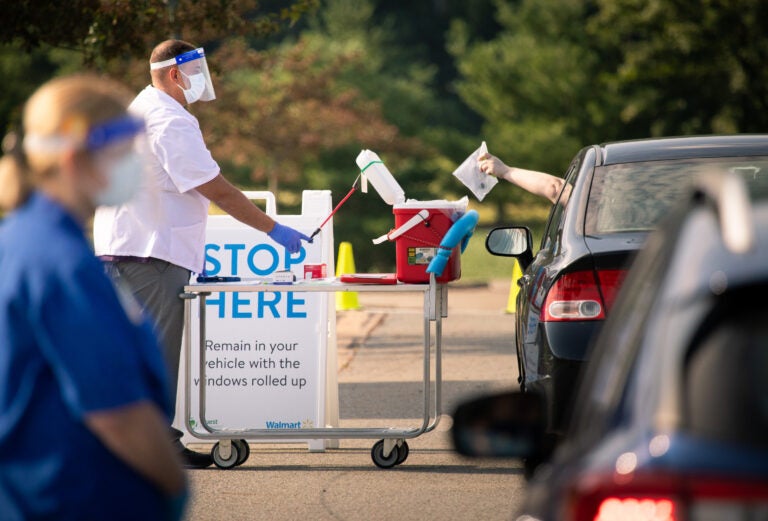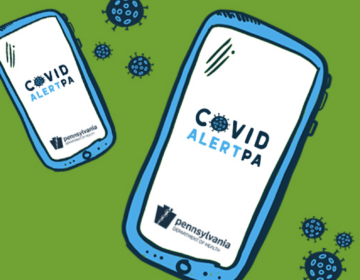Pa. coronavirus recovery: Health officials unveil new testing guidelines
Testing and Contact Tracing Director Michael Huff said the tiered approach to testing will prioritize the most vulnerable.

Employees operate a testing center at a Walmart Supercenter in Elizabethville, Pa. (Office of Gov. Tom Wolf)
Updated at 6:45 p.m.
–
Are you on the front lines of the coronavirus? Help us report on the pandemic.
A day after touting Pennsylvania’s expanded coronavirus-testing capacity, health officials laid out testing priorities that highlight the limited number of tests available.
The commonwealth’s Testing and Contact Tracing Director Michael Huff said the tiered approach to testing will prioritize the most vulnerable using both molecular and antigen tests.
Huff called molecular tests, such as PCR tests, the “gold standard” in COVID-19 testing, though supply is not widely available and getting test results back can take time. Antigen test results can come back within the day but are less accurate.
“We continue building up our COVID-19 testing capacities, to prepare for future outbreaks, and surveillance to rapidly identify disease and mitigate it,” said Huff. “The key is to quickly respond as the landscape changes.”
On Tuesday, Gov. Tom Wolf touted the commonwealth’s 30-day average of conducting 23,000 COVID-19 tests a day and six-month supply stock of personal protective equipment.
Still, Huff said top priority would be given to those hospitalized with coronavirus symptoms, symptomatic people with known contact with someone who tested positive, and asymptomatic people with underlying conditions who have crossed paths with someone who tested positive.
“Tier two” priority will be given to anyone else with COVID-19 symptoms, as well as asymptomatic people who have had close contact with someone who tested positive (no underlying condition necessary). People who live or work in congregate settings such as long-term care facilities or correctional facilities also fall in this category.
People who work in industries such as retail, manufacturing, and food service fall in the third tier of testing. These are people who have public-facing positions or may not be able to keep six feet of distance from other workers at their jobs.
Asymptomatic people who don’t fall into these categories are part of the final tier of priority.
The guidance to providers comes as Pennsylvania and health officials work to control outbreaks at college campuses.
“The commonwealth will continue to review where the greatest need for testing is and leverage testing capabilities accordingly,” said Huff.
On Tuesday, the Wolf unveiled a new phone app that uses bluetooth technology to help in contact-tracing efforts.
Health officials highlight insurance coverage options
Health officials also want residents to know that they have options for health insurance coverage should they lose a private plan they get through work.
“No Pennsylvanian who needs a test should forego testing for any reason, including the fear of what that test may cost,” said Insurance Commissioner Jessica Altman, who explained COVID-19 testing, when deemed appropriate by a provider, is covered through any comprehensive coverage plans.
Altman said families who lose existing coverage through work could seek a replacement through the Affordable Care Act, the Children’s Health Insurance Program or COBRA – though COBRA tends to be more expensive.
Should residents experience a significant life change such as losing work and subsequently their insurance, they may be eligible for a special enrollment period for coverage.
But Pennsylvania residents will no longer have to go through the healthcare.gov website. On Tuesday, Pennsylvania unveiled Pennie, its state-run insurance exchange, which officials expect will save residents money on premiums and simplify the enrollment process.
For those who don’t have a significant life change, open enrollment runs from November 1 to January 15 for coverage in 2021.

Get daily updates from WHYY News!
WHYY is your source for fact-based, in-depth journalism and information. As a nonprofit organization, we rely on financial support from readers like you. Please give today.



![CoronavirusPandemic_1024x512[1]](https://whyy.org/wp-content/uploads/2020/03/CoronavirusPandemic_1024x5121-300x150.jpg)



